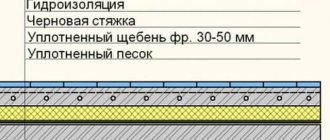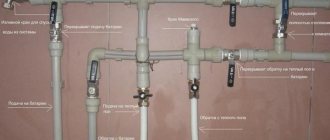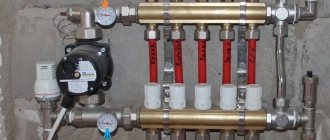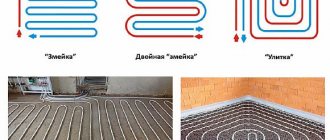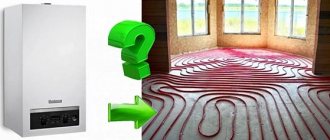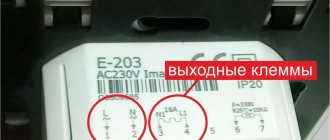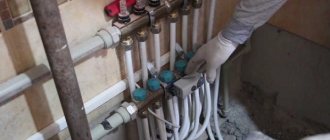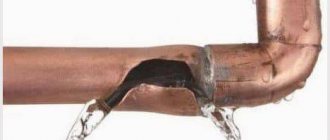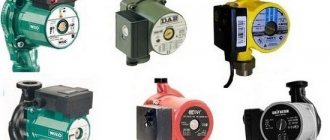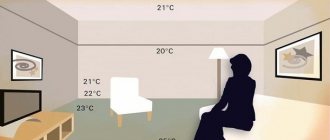Warm water floors have proven themselves to be the best: they are absolutely safe for humans and effectively cope not only with the task of heating, but also with heating rooms. In addition, given the long service life, such systems are much cheaper than electric ones. But at the initial stage they will require very significant investments, which is associated with the purchase of special equipment and difficulties during installation.
Accessories for water heated floors
The selection of all components must be done with all responsibility, since any mistake can be too expensive. When buying necessary things at a hardware store, it would not be superfluous to ask the seller for product certificates in order to protect yourself from purchasing counterfeit goods.
Warm floor
So, what is required to equip your home with a water heated floor system? First of all, consultation with competent specialists. The boiler capacity, pump power, pipe length, optimal cross-section and method of laying them are calculated through complex calculations, which are best left to professionals. Only with all the necessary information can you make a truly effective heated floor.
- 3.1 Video - Mixing unit for heated floors
- 4.1 Video - Accessories for water heated floors. Collector
Pipes and fasteners
Perhaps the pipes are the most important element of the entire system, a kind of radiator, only embedded in the floor. Naturally, this makes it impossible to control their condition and makes repairs extremely difficult if the need arises. Therefore, it is very important to be sure that the pipes laid in the screed are strong, durable, do not rust and do not collapse over time from exposure to internal and external loads.
Only a thermal imager can detect a leak
Warm floor - thermogram
There are several types of pipes for water floors on the construction market, and each has its own pros and cons. Only products made of ferrous metals are prohibited for use, since the seam they have is a weak point. By the way, for the same reasons, any joints and connections of pipes in the thickness of the screed are prohibited - the contour must be solid.
Types of pipes
Copper. Perhaps the best option, which would have no equal among analogues if not for the price. The cost of pipes, fasteners and connecting units is quite high, and if we add to it the need to use special complex equipment, then the resulting price tag will be unaffordable for many.
However, in return, you will receive a strong and durable system of pipes with the highest heat transfer, withstanding temperatures up to 250°C and not bursting when frozen. Copper pipes can be bent at any angle, albeit using special equipment, and can withstand significant loads.
Copper pipes KME (Germany)
Pipes made of cross-linked polyethylene, silt RE - X. At the moment they are the most popular for installing warm water floors. Cross-linking, that is, a special treatment of polyethylene, promotes the appearance of additional bonds between polymer molecules, due to which the finished products become durable and heat-resistant (withstand temperatures up to 125°C).
XLPE pipes
Since polyethylene is an oxygen-permeable material, the pipes are additionally coated with a special anti-diffusion layer. Water flows through such pipes almost silently, since the material has a high degree of sound absorption. Elasticity allows pipes to be bent with the required pitch, and all these advantages, combined with an affordable price, allow the products to occupy a leading position in the market.
Pipes for heated floors made of cross-linked polyethylene
Video - Pipes for heated floors made of cross-linked polyethylene
Metal-plastic pipes. They consist of three main layers (certain types of pipes are made of five layers), connected by a special adhesive. There are layers of durable polyethylene on the outside and inside, and the central layer is foil. It increases thermal conductivity, acts as an oxygen barrier, increases the strength of pipes and makes them easier to bend.
Five-layer metal-plastic pipe PERT-AL-PER
Polypropylene. The cheapest option, but practically not used for warm floors. The main reason is insufficient elasticity. The pipe cannot be bent more than 8 diameters, so it is impossible to lay it with the required spacing. In addition, the density and heat transfer of polypropylene is less than that of polyethylene.
Polypropylene pipes are not the best option
Thermal insulation
The construction market offers a wide selection of materials that prevent heat from escaping through the floor. There are even special mats designed directly for laying heated floors.
Mats for warm water floors
They come in different thicknesses, have the necessary strength, light weight, and even have a specific surface topography that allows pipes to be positioned and fixed. Of course, it is best to use such products, since they provide all the important nuances.
Expanded polystyrene mats for heated floors (with bosses)
This will only have a slight effect on the cost of repairs, since such mats essentially combine thermal insulation, waterproofing, reinforcing mesh and fasteners. Pipes laid in accordance with the chosen scheme must be secured to the floor with special clamps, and the bosses of heat-insulating mats eliminate this need.
Profile mats for water heated floors
Thin foil materials, for example, penofol, do not provide reliable thermal insulation, so their use only makes sense if the floor has already been insulated in advance and the goal is to save on the thickness of the screed. In addition, it does not have fastenings for pipes, so you will have to lay a reinforcing mesh.
Profile thermal insulation boards are made of polystyrene foam with a density of 40 kg per cubic meter
More advanced are mats made from extruded polystyrene foam. Particularly high-tech options even have markings for laying and a waterproofing layer, and also allow pipes to be secured with brackets.
Video - Mixing unit for heated floors
Warm floor pie
When installing a heated floor, multilayer thermal and waterproofing is prepared under it. In common people it is called “pie”. It consists of:
- Waterproofing;
- Thermal reflective material;
- Insulation.
Ordinary polyethylene or special membranes are used as waterproofing. They perform two functions - they protect the insulation from moisture penetration from below and protect the ceilings in case of leaks.
Thermal reflective material is designed to reflect infrared radiation. It represents a metal foil, or a polymer substrate on an aluminum base. The use of heat-reflecting substrates can increase the efficiency of a warm water floor by 20-30%.
The following can be used as insulation:
- Expanded polystyrene;
- Styrofoam;
- Cork;
- Mineral wool;
- Expanded clay;
- Expanded vermiculite.
Warm water floor pie design.
Distribution manifold and cabinet for it
A manifold with fittings is needed to connect the laid pipes to the heating boiler. The characteristics of the device for controlling the movement of fluid in the system are calculated in advance, and the manifold is placed in a niche or a special cabinet, which will have to be purchased additionally.
Main elements of the collector unit
The device allows you to connect several loops, the number of which depends on the size of the room. The pipes are connected with compression cone fittings and are equipped with shut-off valves, which, if necessary, will stop the flow of water into the mains. A coolant flow meter is also installed on each loop. At the outlet of the collector there is usually a splitter with an air vent that bleeds air when it gets in, and a drain valve that allows you to drain the water.
Built-in underfloor heating manifold with mixing unit
To control the water temperature at both ends of the loops, the entire system is equipped with automatic devices: thermostats and servos.
Video - Accessories for water heated floors. Collector
How does a warm water floor work and how does it work?
First, let's talk about the general design of a water-heated floor. It is a system of pipes laid in the floor structure through which coolant flows. The floor heats up due to the fact that the coolant gives off its heat.
What is required for a water heated floor
The coolant is either water or an antifreeze liquid. In most cases, water is used. It is heated by a boiler. Sometimes new multi-storey buildings have special risers for connecting water heated floors. But this is the exception rather than the rule. Therefore, we will talk about a heated floor system powered by a boiler.
Purpose of the main nodes
The underfloor heating pipes are looped and connected to the boiler through a special mixing unit. One end is for supply, the other is for return. The task of the mixing unit is to lower the temperature of the coolant, which at the outlet of the boiler can reach 90°C and higher. Typically, a heated floor is a secondary heating system, and the main heat is provided by radiators. This is where hot water is supplied. The maximum possible supply of coolant to the heated floor pipes is 35-45°C (depending on the type of floor covering). Otherwise it will be too hot and uncomfortable.
Equipment for water heated floors: general diagram
It is difficult to do without a collector distribution system. This equipment serves to equalize the coolant temperature in different circuits (pipe loops) of a water heated floor. The fact is that the length of the heated floor pipe is limited. It depends on the power of the boiler, the performance of the pump, the cross-section of the pipe itself, and the material from which it is made.
An example of the layout of the contours of a warm water floor
Usually one circuit is about 50 meters of pipe. It may be more or less. In the presence of a collector group, the minimum is not limited, and the maximum is approximately 70 meters. Moreover, even in a small room you have to lay more than one loop. And the loops are usually of different lengths. If you supply water with the same temperature to loops of different lengths, the long one will have very cold water at the outlet, and the short one will have quite warm water. This leads to different heating of the floor. That is, some piece can be hot, and some can be noticeably cold. The collector unit is responsible for equalizing temperatures.
It has one more use. It makes it possible to set different floor temperatures in different rooms. For example, you can make the bathroom warmer, the living room cooler. Or whatever you want.
List of required components
The diagram does not show all the components and necessary materials that will be required to install a warm water floor. Below is a more complete list with brief notes. We will assume that all preliminary work has been carried out, floor insulation is already present or there is no need for it. We will also not count concrete or sand-cement mixture. Their thickness and required quantity are calculated separately. We also do not take into account exactly how the water will be heated, as well as the supply pipes. Taking into account all these “buts”, here’s what you need for a warm water floor:
- Pipes. They will be needed in large quantities. Must be flexible, reliable, capable of withstanding high pressure and temperature for a long time.
- Pipe fastening system. They are laid according to a certain pattern with a certain (calculated) step. To prevent them from moving when pouring concrete, they must be secured.
- Mixing and pumping unit. It is used to obtain water at a given temperature, and the pump is used to overcome the hydraulic resistance of the system.
Components for a warm water floor: what will be needed to install the system - Collector system. For “distributing and collecting” coolant along the contours of a heated floor. Can be equipped with flow meters or thermostatic valves. They serve to regulate the temperature in each circuit.
- The mixing and collector units are installed in the collector cabinet. This is a metal box in which all the mechanics are packed.
Actually, this is the whole list. But some more fittings and other consumables will be required. It is difficult to list them, since everything depends on the system and the components used.
Boiler and circulation pump
A boiler is needed when heated floors are installed in a private house. In ordinary apartments this is prohibited, but new buildings, where water-heated floors are provided in advance, require their connection to a separate circuit. A circular pump is necessary in any case, as it ensures the movement of water.
The boiler capacity, pump power, as well as the possibility of connecting an additional one depend on the planned capabilities of the system and are calculated in advance. If desired, you can even purchase a ready-made pumping and mixing group.

